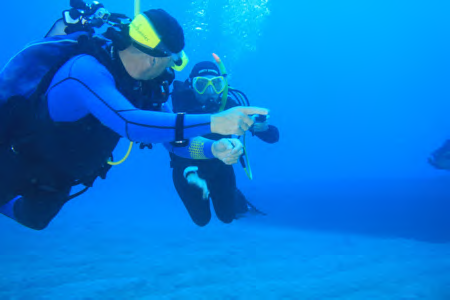Captain’s log: 27th November 2021
Location: Atlantic Ocean, Canary Islands, multiple dive sites
As we arrived in the Canary Islands, we encountered SY Ornella, French Flag again. Onboard, Cpt Thierry and skipper Nathalie are on their way around the world.
Both of them were very interested in learning more about scuba diving as Cpt Thierry already did some diving during two Try Dive sessions over the past years (with one good and one lesser experience somewhere in the world). Skipper Nathalie had a traumatic water experience at a younger age and wanted ‘to beat’ her anxiety for water as she realized that they would be spending the next many years living on/ near the water surface. She showed a keen interest in the underwater world, and scuba diving was her ultimate dream, despite the fear of water and what happened during her youth. “The will & desire to do so”… do you remember that phrase from the NAUI S&P?
It only takes a patient instructor to teach the Open Water Scuba Diver course and onboard SY Blowing Bubbles. We are always up for a challenge, and believe me, we are patient!!
We took the time to go through the NAUI Open Water Scuba Diver course, clearly explaining all parts and steps involved. We then reviewed that certification was only reached upon successfully reaching all standards inside the course. Next, we had another difficult task to set: how to calculate the costs for this course?
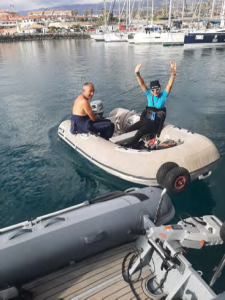 As Thierry & Nathalie are not guests onboard SY Blowing Bubbles but have their catamaran SY Ornella moored next to SY Blowing Bubbles, their course can not be given for free as we have a job to do, bills to pay, and need food to eat! (All guests onboard NAUI Flagship SY Blowing Bubbles can choose any NAUI recreational scuba course for free during their charter.)
As Thierry & Nathalie are not guests onboard SY Blowing Bubbles but have their catamaran SY Ornella moored next to SY Blowing Bubbles, their course can not be given for free as we have a job to do, bills to pay, and need food to eat! (All guests onboard NAUI Flagship SY Blowing Bubbles can choose any NAUI recreational scuba course for free during their charter.)
The fact that Nathalie had serious water issues pointed towards the fact that a lot of explaining and in-water-time was going to need to be invested. We would need to get her mind free again to trust the aquatic environment and to be able to master all necessary skills to get certified!
As a NAUI professional, how would you set the course, and what package costs would you propose? Good guidelines make good friends, and nothing is more important than making clearcut agreements before starting a course and establishing commitment.
These are the challenges in your professional career that you will either like or step away from!
We, Karen and Jean-Marc, dive instructors onboard the NAUI Flagship, can, of course, NOT step away from these challenges. So we planned and started the Open Water Scuba Diver course with Thierry and Nathalie. Below are the steps that we worked together to put in place.
Step 1: The online course combined with private teaching in the french language as both Thierry and Nathalie are french.
Going through the online theory and helping them understand all parts involved does help people with ‘fears’ open up their minds and understand better what diving is all about. It is just NOT correct to send them the email with the online course link and just sit and wait for them to struggle through those parts and hope for the best…NO WAY!
Going through the theory with them gives you, as an NAUI instructor, the chance to explain in depth what it is all about, to recognize the parts where your students have a ‘click’ or where they struggle to understand what it is all about!
It gives you the possibility to gain their confidence, even before touching the water, which in our case was clearly needed! Using the online course allows you to combine self-study with personal instructor guidance and set your position as an instructor, tutor, mentor, and person of trust.
Step 2: Equipment Preparation.
Most dive centers will prepare the equipment for the first water session themselves (and not involve the students) to save time and energy and have the student focus on the water part coming up.
In our case, we decided to have multiple equipment sessions done, even before going to the water. In addition, as scuba diving is an equipment-dependent sport (for example, freediving is less equipment-dependent), we decided to build a confident-based relationship between our students and the dive equipment to be used during the course. This approach would give our students more awareness and structural knowledge before entering the water.
Do you, as a professional, still remember that scuba dive equipment is somet hing “outside the box”? The scuba equipment is something out of the ordinary; equipment has to give comfort as well as keep you alive. Equipment needs to provide enjoyment while using it? Does the regulator break or malfunction? Do you realize that once you put the regulator in your mouth, you can’t see it yourself anymore? Talking about some “blind” trust your students need to have in their regulator!
These equipment sessions can take up hours as a complete scuba set has many parts to be explained and attached, their functions to be shown and a lot of touching & feeling to be done by the students. But the results of these sessions are needed to establish the ‘click’ some students need to start trusting their equipment to take the next step: going in the water!
Step 3: Going IN the water (and not UNDER water)
After taking the time to set up the equipment, putting the scuba set on your back, and by this, changing the way you feel, move and walk on land (merely by the sheer weight of the scuba set). Just imagine how your student will feel once entering the water and feeling the weight of the scuba set disappearing but instead feeling the water movement taking over and all of a sudden the need to move in a different way to regain control of body position in the water?
Our approach is a slow and controlled entry in the water to help again keep the faith, find balance, and make the student understand that they have control over the equipment. (Doing a giant stride entry or backward boat roll is not what we are talking about). It is all about gaining inch by inch water depth while at the same time building confidence.
How would you feel getting a parachute strung to your back and being pushed out of an airplane for the first time with a skydiving instructor by your side telling you not to worry as he will pull the cord to release the parachute at the right time?? Well, that is exactly how most students will feel on their first dive / Try Dive sessions! As an NAUI Professional, if you have forgotten about that feeling due to your extended dive experience, just sign up for a Try Skydive session and focus on the feelings you will experience. I will promise you; you will even become a better scuba instructor!
Our in-water sessions were both handling shore-based and boat-based entries. Thierry & Nathalie were living on a boat and so would be faced a lot with diving of their boat. We even extended the boat-based parts by using both their catamaran and their dinghy to enter the water as entering the water from a dinghy is completely different compared to a commercial dive-vessel. It is not only about entering the water; there is also the part of exiting! Most sailboats and dinghies have no dive ladders that you can use to exit the water!
So, exiting the water means taking the weights off, taking the BCD/tank off in the water, just floating on the surface and getting at least one person at first in the dinghy to start bringing in the floating BCD/tank and helping the other diver(s) to get into the dinghy or onto the boat. Most sailboats will have a swim ladder to get in/out of the water, but these ladders can not support a scuba diver loaded with a full scuba set on its back, so the same procedure needs to be used!
Now, are you still ‘calculating’ the time and energy spent on this NAUI Open Water course?
We still haven’t entered the underwater world. We are still on the surface, building trust and confidence! We are still taking our time to connect the student to the water!
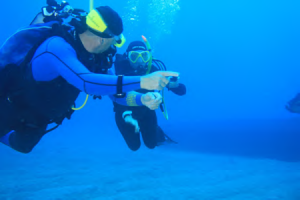
Step 4: Guess what, time to blow some bubbles…yeah, what’s in a name?
After steps one, two and three were done, and we had taken the time to build trust and confidence, we are now getting to the first breathing in-water experience.
There goes the regulator in the mouth and thus disappearing from the student’s view. Then, standing on the ocean floor, the first breaths are taken and water depth reaching up to the student’s waist. Never forget, if you are 1m85 tall (6ft something) and your student is not, make sure that you have the waterline to the waist of your student and not yours!! This is because they could be neck-deep in the water at that moment, and believe me, that will not give them the same feeling to start with!
When you are breathing through a mouthpiece for the first time it might feel like it is stuck between your teeth! Do you remember your first time? Of course not, as you have done it about 1000 times.
Take the time to have our students connect to it. Like breathing, in general, is the most important thing they (and you) will do for the rest of your life, warranting a long life if you succeed in keeping up with it! However, breathing through a scuba regulator is completely different, and many people need extended time to get used to it. Immediately setting off into the underwater world will not help these people control their breathing pattern. With disturbed breathing, well, this first underwater session was already doomed before it even started.
Breathing, controlling inhaling, and even as important exhaling (through the mouth and not the nose), just takes time. And believe me, doing this while standing in waist-deep water is a different experience compared to doing this on land, standing dry in your shoes.
Step 5: Going to have a look beneath the surface?
Are you always aware of the field of vision that your student has?
When bending forward to take the first breaths underwater, your student’s field of view changes completely and so often, may loose the connection with the instructor? On top of that, their body balance will change as well! So, as the instructor sits down on your knees in front of the student, they can see you, see your breathing pattern, and the exhaled bubbles’ formation. You will become a point of support as well if they lose balance due to the new position they are getting into.
The next part is to breathe and communicate! Did you explain the signs needed to make your students aware that they can communicate underwater without being able to speak??
Seeing deaf people use sign language is quite the thing, and even to me (speaking and being able to teach scuba courses in eight languages), sign language is spectacular! Scuba divers use sign language, and your students need time to adapt to this practice. Have fun using the hand signals, and yes, many divers will keep using some scuba hand signals in daily life! My scuba “Ok-signal” has already been replacing the ‘thumbs up’ signal for many years, actually most of the time. I just forget that not all people are scuba divers (why not?) and so do not understand me when I am showing them two fingers making a little circle between them…
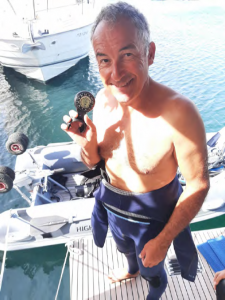 Step 6-7-8-9-10-11-12-13-14-15-16-17-18-19-20-…
Step 6-7-8-9-10-11-12-13-14-15-16-17-18-19-20-…
As a well-trained NAUI Scuba Instructor, by now, you should have realized that in the above-explained steps, I am just writing in detail, combined with some feeling, how to perform a Try Dive!
And continuing this way, I could probably write a complete book on how to complete a full NAUI Open Water Scuba Diver course in detail by combining them/ pointing out the baby steps to be taken with students who are not Superman before entering the water. Well, our NAUI dive magazine Sources is not the place to publish a complete book, and so we return to Thierry & Nathalie and their scuba course onboard SY Blowing Bubbles
The last step?
After 20 scuba dives and taking up to +250 hours of teaching, in-water, in-depth, and on land, both Nathalie and Thierry finished their NAUI Open Water Scuba Diver course!
Even going a step further! Thierry also finished his NAUI Advanced Scuba Diver course, and Nathalie will soon do as well.
 Two complete dive kits are now put onboard their catamaran, the SY Ornella. Even a compressor was installed onboard to fill their dive tanks to be independent wherever they decide to travel and dive. They will be able to jump in the ocean to discover the underwater world during their next years of travel to come!
Two complete dive kits are now put onboard their catamaran, the SY Ornella. Even a compressor was installed onboard to fill their dive tanks to be independent wherever they decide to travel and dive. They will be able to jump in the ocean to discover the underwater world during their next years of travel to come!
Will there ever be the last step in this story?
Below you will find the comments about the dive course we asked to Thierry and Nathalie to write:
As a child, I have survived a traumatic near-drowning experience that has created lifelong water anxiety.
At the age of 30, I wanted to break this anxiety down and took several classes of fighting against water phobia, resulting in little progress as I was convinced my body would always sink down and be submerged once entering the water. This resulted in me never going into water surfaces anymore where I couldn’t see my feet touch the bottom.
At this moment, we are living on our sailboat for two years, and I came to terms that I really had to fight and gain victory over my fear of water. What a shame it would be to be on anchor in beautiful clear blue water and NOT being able to enter the water?
In 2020, when preparing our boat in France, Port Leucate, we met SY Blowing Bubbles and owners Karen & Jean-Marc. They had spoken several times about scuba diving and the possibilities it could give me in beating my fear of water. They understood my ‘problems’ and were ready to create a path and guide me throughout my journey to beat my fear, using scuba diving.
Imagine me, afraid of being submerged and signing up for a scuba diving course?? So dates were defined, the location was set, and the Canary Islands were the place to meet again to start the practical part of scuba diving, so I could do the NAUI online course before arriving there.
With a great deal of super confidence in my Instructors, Karen and Jean-Marc, I am sitting on the side of the RHIB, ready to enter the water with my scuba gear. Putting the fins on my feet, putting my feet in the water alongside the RHIB, believe me, it sounds easier. During the complete course, the psychological approach and time taken have given me the time needed—step by step, each time discovering a new part of possibilities within scuba diving.
My fears were starting to be cut in pieces, each piece dissolving in new emotions discovered by each diving session. The first dive was a real revelation to me due to the attitude of Jean-Marc, explaining every step, every movement and considering every ‘psychological block’ towards each next step. The road was going to be long, and both I and Jean-Marc were having the energy to get to the end of it.
This was going to be the beginning of a great adventure, and I was ready for it!
Step by step, I progressed, thanks to the patience of my instructors and the skills in teaching they possess. Every step I took was a step with less anxiety, less fear and more sense of possibilities, freedom and confidence in my possibilities.
Different dive sites were chosen by Jean-Marc, in order to progress my skills in being underwater, to become more proficient, day by day.
Twenty days of continuous diving, twenty days of working towards one goal, becoming autonomous, becoming a self-confident skilled scuba diver with a serious backbone to counter any problems on my way in the underwater world.
The last step, the last dive, number 21, day 21. The last skill to perform underwater with confidence: taking my mask off and breathing without a mask, having water up my nose, being fully submerged in the ocean, alone! The dive site would be the first dive site where it all started 21 days ago. What a difference, what a day! Next to me was Thierry, who joined me in all these dives to get trained and finish his advanced Scuba Diver course.
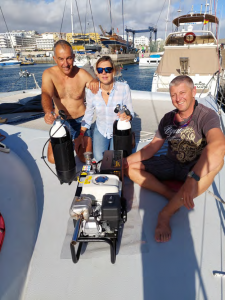
Strongly filled with emotions and feeling 200% secure, I performed the last skills, again and again, feeling I could do it with Thierry next to me, watching me with tears in his eyes!
If I have to summarize this success for me, it would be analyse, trust, understanding, listening, psychology and teaching talent, taking time and, of course, the experience from Jean-Marc and Karen.
So I wish to thank these two instructors for their time, warmth, involvement, energy, and ‘joie de vivre’ and for making sure they were always ‘there’ when I needed them.
Thank you for being who you are!
Nathalie
SY Ornella


